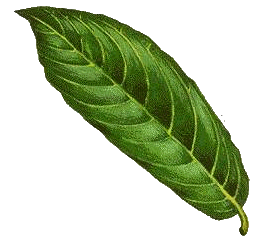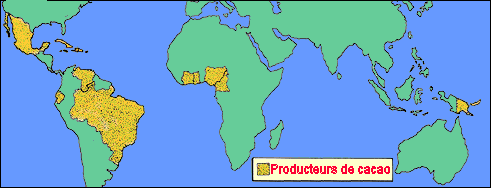Cocoa, Theobroma cocoa
tree of the family Sterculiaceae (Sterculia, Cola)
 Etymology: the botanical genus is named Theobroma ("food of the Gods") in reference to the sacred origin of the tree for the Indians of America. Term "Cocoa" comes from Aztec words as "Cachoatl", "Cacaohatl" or "Cacaoquahuul" (Cocoa - according to the father Labat, travels New in the isles of America, Paris 1722). Word "Chocolate" comes of Aztec "Tchocolatl" or from the Mayan " xocoatl ", formed by "Choco" or " xoco " (noise) and " atl " (water), to allude to noise of the preparation when the Incas were waving cocoa in water to dissolve. Etymology: the botanical genus is named Theobroma ("food of the Gods") in reference to the sacred origin of the tree for the Indians of America. Term "Cocoa" comes from Aztec words as "Cachoatl", "Cacaohatl" or "Cacaoquahuul" (Cocoa - according to the father Labat, travels New in the isles of America, Paris 1722). Word "Chocolate" comes of Aztec "Tchocolatl" or from the Mayan " xocoatl ", formed by "Choco" or " xoco " (noise) and " atl " (water), to allude to noise of the preparation when the Incas were waving cocoa in water to dissolve.
Origin: Tropical America, basins of the Amazon and of Orenoque. The Cocoa was discovered by the expedition of Fernando Cortez, in 1519.
Habitat: tropical countries. The cocoa demands a well drained, hot, humid ground, and covered in its youth (property which it shares with the coffee tree and the cinchona). The cocoa grows to shade. They plant, at the same time as Cocoas, covering trees, most often from Cockspur Coral Trees, which are fluently called "mother" of the cocoa.
Height: 10 m tall. For farm reasons, the Cocoa is pruned more low, between 3 - 8 metres high.
Persistent foliage. Leaves alternate, oblong, green shiny, in petiole provided with a joint which allows them to turn according to luminous intensity. Leaves resemble leaves of chestnut trees.
Flowers: small, white or yellow, appear directly on the trunk or on the old branches (cauliflorous, like the Judas tree, or Sterculia of the same family). The flower is present on the tree practically all year long. Fruits together on the tree are permanently found, flowers, leaves. The orange tree or the lemon tree also have flowers and fruits at the same time but shorter.
Fruits: big ovoid berries from 10 to 25 cm long, 15 cm broad, weighing 500 grammes. They are called "pod". The smooth or wartlike, red-brown envelope with maturity, locks up a soft pulp containing 25 - 75 seeds from 2 to 2,5 cm in length, called cocoa beans because of their form and of their dimension. The Cocoa produces from 4 - 5 years, and attains full output between 10 and 25 years.
Uses: the broad beans of the Cocoa are rich in starch, in fats and in alkaloids (theobromine and caffeine). The cocoa is extracted from it. They are let ferment during 2 - 7 days, until they are ready for the preparation which will give the chocolate. They also give the cacao butter, used in confectionery, in chemist's shop and in beauty product. The theobromine is extracted from germs and teguments of the seed for its diuretic properties. Many remedial virtues in the cocoa are lent:
- against the bad cholesterol (LDL) thanks to the acid oleic ('olive oil '), the acid stearic, phytosterols.
- against constipation (tannins hydrolyzables),
- against stress (theobromine, phenylethylamine, caffeine, serotonin, Magnesium),
- and a diuretic effect (Theobromine).

Amerindian legend:
the God of vegetation Quetzalcoalt in Aztec (Snake with feathers) taught art to cultivate the Cocoa to a toltec princess (from the north of Mexico City in Xth century) in reward of her fidelity to his worship. When her spouse left to war, she refused to point the place out where she cultivated cocoas. Toltecs killed her and of the blood, cocoa started to grow: bitterness of the bean reminds the suffering of the princess, and the red colour of pods reminds the noble blood which was poured.
|
 Etymology: the botanical genus is named Theobroma ("food of the Gods") in reference to the sacred origin of the tree for the Indians of America. Term "Cocoa" comes from Aztec words as "Cachoatl", "Cacaohatl" or "Cacaoquahuul" (Cocoa - according to the father Labat, travels New in the isles of America, Paris 1722). Word "Chocolate" comes of Aztec "Tchocolatl" or from the Mayan " xocoatl ", formed by "Choco" or " xoco " (noise) and " atl " (water), to allude to noise of the preparation when the Incas were waving cocoa in water to dissolve.
Etymology: the botanical genus is named Theobroma ("food of the Gods") in reference to the sacred origin of the tree for the Indians of America. Term "Cocoa" comes from Aztec words as "Cachoatl", "Cacaohatl" or "Cacaoquahuul" (Cocoa - according to the father Labat, travels New in the isles of America, Paris 1722). Word "Chocolate" comes of Aztec "Tchocolatl" or from the Mayan " xocoatl ", formed by "Choco" or " xoco " (noise) and " atl " (water), to allude to noise of the preparation when the Incas were waving cocoa in water to dissolve. 